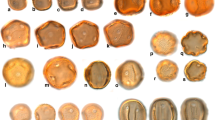Abstract
Theligonum cynocrambe and 13 species ofRubiaceae contain S-type sieve-element plastids, wide-spread in Dicotyledons. Alignment ofTheligonum toCaryophyllales (Centrospermae), especiallyPhytolaccaceae, is unlikely, because this order is characterized by specific P-type plastids. SEM investigations show the pollen exine ofTheligonum to be microreticulate, with additional supratectate spinules.Asperula and other genera of the tribeRubieae have a tectum perforatum (punctitegillate sexine), also with supratectate verrucae or spinulae.—Thus ultrastructure suggests (but not definitely proves) relationships betweenTheligonum andRubiaceae, while affinities betweenTheligonum andCaryophyllales are excluded.
Similar content being viewed by others
Literaturverzeichnis
Baillon, H., 1873: Histoire des plantes. Paris.
Behnke, H.-D., 1972: Sieve-tube plastids in relation to angiosperm systematics. An attempt towards a classification by ultrastructural analysis. Bot. Rev.38, 155–197.
—, 1975: P-type sieve-element plastids: A correlative ultrastructural and ultrahistochemical study on the diversity and uniformity of a new reliable character in seed plant systematics. Protoplasma83, 91–101.
Bortenschlager, S., 1973: Morphologie pollinique desPhytolaccaceae. Pollen et Spores15, 227–253.
Cronquist, A., 1968: The evolution and classification of flowering plants. London: Nelson.
Erdtman, G., 1966: Pollen morphology and plant taxonomy. Angiosperms, 2nd, ed. New York-London: Hafner.
Hutchinson, J., 1969: Evolution and phylogeny of flowering plants. Dicotyledons: Facts and Theory. London.
Kooiman, P., 1971: Ein phytochemischer Beitrag zur Lösung des Verwandtschaftsproblems derTheligonaceae. Österr. Bot. Z.119, 395–398.
Leuenberger, B., Schill, R., undUhlarz, H., 1973: Eine Methode zur Herstellung von Exinebruchstücken für pollenmorphologische Untersuchungen im Raster-Elektronenmikroskop. J. Microscopie18, 259–262.
Mabry, T. J., Eifert, I. J., Chang, C., Mabry, H., Kidd, C., andBehnke, H.-D., 1975:Theligonaceae: Pigment and ultrastructural evidence which excludes it from the orderCentrospermae. Biochem. Syst. and Ecol.3 (in press).
Melchior, H., 1964:Myrtiflorae. In:Englers Syllabus der Pflanzenfamilien II., 12. Aufl. Berlin: Bornträger.
Nowicke, J. W., 1975: Preliminary survey of pollen morphology in the orderCentrospermae. Grana (in press).
Praglowski, J., 1973: The pollen morphology of theTheligonaceae with reference to taxonomy. Pollen et Spores15, 385–396.
Takhtajan, A., 1959: Die Evolution der Angiospermen. Jena: Fischer.
—, 1969: Flowering plants.—Origin and dispersal. Edinburgh: Oliver & Boyd.
—, 1973: Evolution und Ausbreitung der Blütenpflanzen. Stuttgart: Fischer.
Wunderlich, R., 1971: Die systematische Stellung vonTheligonum. Österr. Bot. Z.119, 329–394.
Author information
Authors and Affiliations
Rights and permissions
About this article
Cite this article
Behnke, H.D. Elektronenmikroskopische Untersuchungen zur Frage der verwandtschaftlichen Beziehungen zwischenTheligonum undRubiaceae: Feinbau der Siebelement-Plastiden und Anmerkungen zur Struktur der Pollenexine. Pl Syst Evol 123, 317–326 (1975). https://doi.org/10.1007/BF00987062
Received:
Issue Date:
DOI: https://doi.org/10.1007/BF00987062




